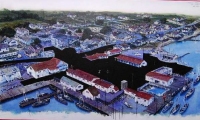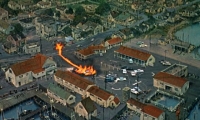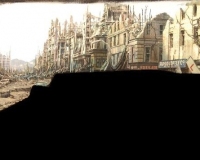Matte Painting is a simple way of enhancing an environment on location by simply painting on a sheet of glass that’s placed in front of the camera. Part of the glass remains unpainted, and this is where the live action can be seen through the glass.
A matte painting can also establish a scene with certain live action elements superimposed over it. In this case, the entire view of the camera would be painted, with live elements (often 3 or 4 birds) placed over it to convince the viewer it’s a real location. Since the mid 1980s, matte paintings have involved some digital manipulation, and since the late 1990s, the paint has been entirely replaced with digital tools.
Examples of Matte Paintings
The Birds (1963)
This original matte painting (believed to be by Albert Whitlock) was on display at Universal Studios, Hollywood. It’s featured in the climactic sequence where the gas station catches fire. The black section shows where the location-filmed footage will appear.
Below as well is a still from the movie showing how the live action and fire effects footage blends with the matte painting.
Earthquake (1974)
Another matte painting by Albert Whitlock, at Universal Studios Florida, in the Earthquake attraction.
Key Dates and Matte Work
- ‘The Wizard of Oz’ (1939) – The Emerald City
- ‘The Thief of Baghdad‘ (1940)
- ‘Citizen Kane’ (1941) – Xanadu
- ‘Black Narcissus‘ (1947) – Extensive matte work to extend shots largely created on stages and backlot at Pinewood Studios (UK) to the Himalayas.
- ‘The Birds’ (1963) – aerial view of the town (see above)
- ‘Planet of the Apes‘ (1968) – Statue of Liberty image
- ‘Earthquake’ (1974) – artist Albert Whitlock painted over 70 individual paintings, earning him an Academy Award.
- ‘Star Wars Episode IV: A New Hope‘ (1977) – the tractor beam set.
- ‘Raiders of the Lost Ark’ (1981) – the final shot of the government warehouse was painted on glass by Michael Pangrazio at Industrial Light and Magic, and combined with live-action footage of a government worker pushing the crate up the center aisle. The integration of the live action lighting and painted lighting effects is perfect!
- ‘Indiana Jones and the Temple of Doom’ (1984) – Pankot Palace, Cliff, The Village [The Raider.Net articleabout the matte paintings]
- ‘Young Sherlock Holmes‘ (1985) – The first digital matte shot was created by artist Chris Evans. A stained glass window was painted in acrylics then scanned into LucasFilm’s Pixar computer system for digital manipulation. The computer animated Stained-Glass Knight character (the first digitally created character in a motion picture) blended seamlessly with the window.
- ‘The Curious Case of Benjamin Button‘ (2008) – Click for Matte World’s website showing some amazing before & after photos showing how important digital matte paintings were for this movie.
Matte Painting Artists
- Linwood G. Dunn
- Harrison Ellenshaw
- Peter Ellenshaw (Disney)
- Michael Pangrazio (ILM)
- Albert Whitlock (Universal Studios, Disney)
- Matthew Yuricich
See also
- Wikipedia Page
- Matte World Digital
- Matte Painting.Org – examples of matte paintings and resources



